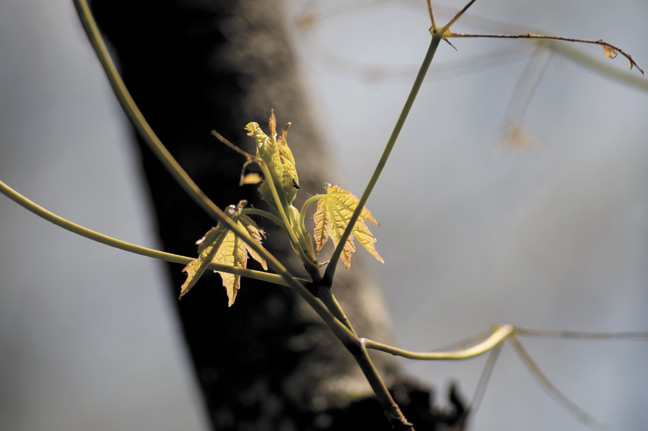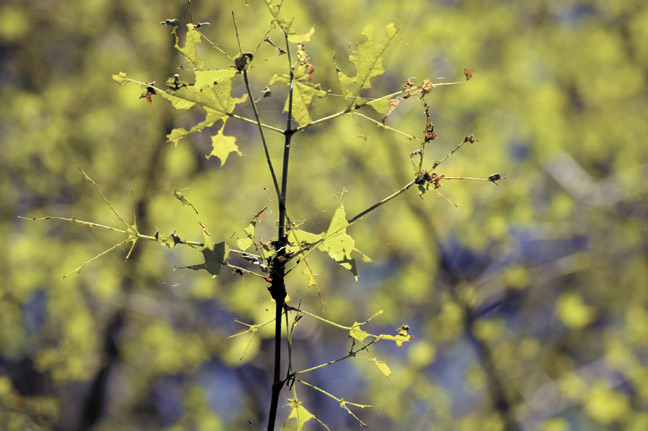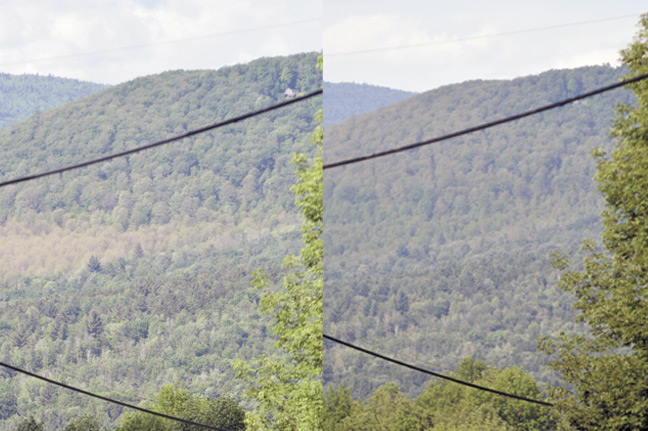UVM Proctor Page
Devastating caterpillar
Insects eating their way through Vt. sugar maples
By BY MARK ISSELHARDT, UVM EXTENSION, MAPLE SPECIALIST | SEPTEMBER 2016
An infestation of forest tent caterpillar or FTC (Malacosoma disstria) has developed in several parts of Vermont this summer. This early-season defoliator is a native insect and has the potential to defoliate large areas of hardwood forest. Sugar maple is one of the caterpillars preferred host trees.
Periodic FTC outbreaks follow a 10 to 20-year cycle on a regional level. At the stand level, outbreaks usually last less than 3 years although in some cases stands have been defoliated for up to 6 years. North-central and northeastern parts of Vermont appear to be most impacted in the first year of this outbreak. Vermont Department of Forests, Parks and Recreation (VFP&R) is surveying the extent of the defoliation. So far, roughly two thirds of the state have been mapped and 14,000 acres of defoliation from FTC have been observed.
There are reports of FTC related defoliation in New Hampshire (~9,500 acres mapped so far), Ontario and southern Quebec. The last widespread outbreak in Vermont (2002-2007) reached its peak around 2006. During that outbreak, the central and southern parts of the state were most affected and about 10% if the states forests (343,000 acres) were defoliated (VFP&R 2016).
The extent and duration of this outbreak will be determined by many factors including: weather, response of natural predators, the health of the forest in the years prior and the growing conditions following the outbreak.
FTC produces only one generation per year. The young caterpillars emerge in late spring, generally right around the time of bud break and early leaf emergence. The caterpillars then feed for 5-6 weeks as they undergo five distinct growth stages (instars). Larger caterpillars require more food and correspondingly produce greater amounts of defoliation.
The caterpillars are social and tend to congregate in groups or ‘colonies’ during the day to rest and for protection from predators. As food becomes scarce, a few caterpillars from each colony will move to find new sites. The rest of the colony will follow scent trails that were left behind by earlier caterpillars. FTC does the greatest amount of feeding at night. Following the last instar the caterpillar produces a cocoon usually between two leaves, although any protected spot can be used. The moths that hatch from those cocoons are light brown or tan in color and are about ¾” long and only live 4-5 days. Eggs are laid in tight masses on small twigs and overwinter in the trees crown. A female moth is capable of laying a 300 eggs per year. Assuming the eggs survive the winter, a new generation of caterpillars will emerge in late May and begin feeding. It should be noted that FTC does not produce the very visible ‘tent’ often seen in the crotch of cherry or apple limbs, those tents are produced by another native insect, eastern tent caterpillar (Malacosoma americanum).
Not all stands of sugar maple will respond the same to defoliation from FTC. By the end of July, severely defoliated trees will have produced a new set of leafs. Some trees with less severe defoliation will retain damaged leafs. In some rare cases trees can be defoliated twice in one summer if enough caterpillars are still feeding when the new leaves emerge. The greatest short-term impact to defoliated trees is a reduction in stem growth and increased risk of decline and mortality. Severely defoliated trees can see growth reduced by 50% or more. Stem growth is impacted both in the years of the outbreak and generally for the succeeding 1-3 years. This lag in growth following defoliation may be caused by an overall reduction in non-structural carbohydrate (starch and sugar) concentrations and a shift in how those carbohydrates are allocated. The increase in the average sugar maple mortality of previously healthy stands (0.5-1%) to greater than 3-4% has been associated with trees growing on poorer quality sites, a recent history of crown dieback and those growing in drier conditions in the year of defoliation (Pitel and Yanai 2014). There is a lack of conclusive evidence to suggest that trees defoliated in the late spring and summer will have lower than average sap sugar content the following season. Some sugar makers have observed lower than average sap sweetness after defoliation while others have not. Sugar makers will no doubt also wonder if tapping trees that were defoliated in the previous year(s) will cause serious harm or mortality. Unfortunately, the answers to this question remain unanswered. It appears that trees in a suppressed or intermediate position in the canopy are more susceptible to dieback, decline and mortality then individuals in a dominant/codominant position.
Experimentally, the evidence suggesting that defoliated trees will always have lower sap sugar content limited and inconclusive (Gregory and Wargo 1986). There is also a great deal of uncertainty about what causes populations to erupt. Some indications are that warm, dry early spring weather or reduction in native predator population may set the table for an outbreak. Producers who have an infestation should walk their woods to determine the extent and severity of the outbreak. Besides seeing the live caterpillars, freshly cut leaves on the forest floor can be an indication that this insect is actively feeding.
Being a native insect and part of the forest ecosystem, a host of organisms have adapted to control the populations of FTC. Populations of these natural controls take time to build and there can be a lag of a few years before the FTC populations crash as a result of parasitism, infection and starvation. One very visible parasitic insect is the friendly fly or (Sarcophaga aldrichi). Producers will no doubt see a large increase in the population of friendly flies (aptly named for helping to kill FTC and for not biting humans) in the coming years. Cold winter temperatures and late spring frosts have also been known to limit the populations of FTC. Interestingly, FTC is not known to regularly feed on red maple leafs. Sugar makers may consider retaining some good quality red maples to slow the expansion of future outbreaks. Doing nothing is also a management option given that most trees will survive several years of defoliation.
NEED HELP?
Spraying an option
Maple producers who want to directly control insect populations in their woods will find only one registered for use in the sugarbush: the biological insecticide Bacillus thuringiensis var.kurstaki (Btk). Btk is derived from a naturally occurring bacteria found in soil. A certified organic version of Btk is available. This material damages the gut of the caterpillar. To be effective, caterpillars must ingest it.
To get a reasonable coverage, aerially spraying infested trees is the only realistic option. The timing of spraying is critical and can be challenging. Since larger caterpillars are more resistant, young caterpillars that are actively feeding on newly emerging leaves are targeted. All the complexities of getting ideal weather for flying and applying the Btk must be overcome for spraying to be effective.
Given these limitations, producers should not be surprised if spraying does not have the desired effect. Knowing roughly how severe next year’s defoliation will be can help when deciding whether to spray. A systematic survey of egg masses can help predict the extent of the coming years defoliation. VFP&R can assist Vermont landowners with surveys. Similar help is likely available through various state forest departments.
For more information: Vermont Forest Parks and Recreation (802) 828-1531 or the UVM Extension Maple (802) 899-9926
Gregory, R.A. and Wargo, P.M. 1986. Timing of defoliation and its effect on bud development, starch reserves and sap sugar concentration in sugar maple. Canadian Journal of Forest Research. 16: 10-17.
Pitel, N.E. and Yanai, R.D. 2014. Abiotic and biotic factors influencing sugar maple health: Soils, topography, climate and defoliation. Forest, Range and Wildland Soils. 78:6, p. 2061-2070
Vermont Department of Forest Parks and Recreation. 2016. Forest Tent Caterpillar Update. Vermont Forest Health leaflet.

































